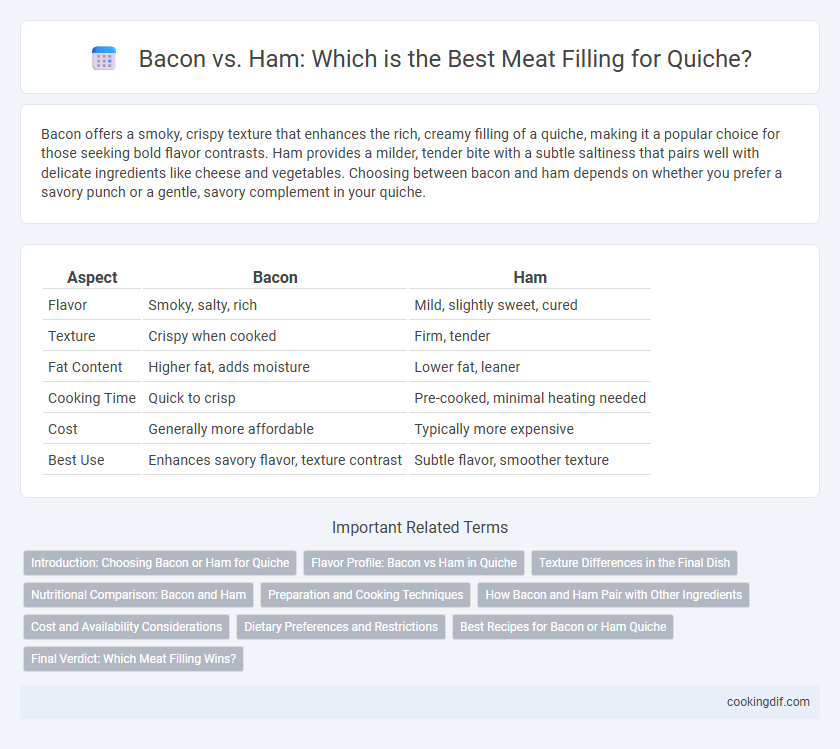Bacon offers a smoky, crispy texture that enhances the rich, creamy filling of a quiche, making it a popular choice for those seeking bold flavor contrasts. Ham provides a milder, tender bite with a subtle saltiness that pairs well with delicate ingredients like cheese and vegetables. Choosing between bacon and ham depends on whether you prefer a savory punch or a gentle, savory complement in your quiche.
Table of Comparison
| Aspect | Bacon | Ham |
|---|---|---|
| Flavor | Smoky, salty, rich | Mild, slightly sweet, cured |
| Texture | Crispy when cooked | Firm, tender |
| Fat Content | Higher fat, adds moisture | Lower fat, leaner |
| Cooking Time | Quick to crisp | Pre-cooked, minimal heating needed |
| Cost | Generally more affordable | Typically more expensive |
| Best Use | Enhances savory flavor, texture contrast | Subtle flavor, smoother texture |
Introduction: Choosing Bacon or Ham for Quiche
Bacon and ham are popular meat choices for quiche, each offering distinct flavors and textures that influence the final dish. Bacon provides a smoky, crispy element with higher fat content, enhancing richness and depth of flavor, while ham delivers a milder, saltier taste with a tender bite that blends smoothly into creamy custards. Selecting between bacon or ham depends on desired flavor intensity and texture balance to complement other ingredients like cheese, vegetables, and herbs in the quiche.
Flavor Profile: Bacon vs Ham in Quiche
Bacon imparts a smoky, salty, and rich flavor that crisps up in the oven, adding a savory crunch contrasting with the creamy quiche filling. Ham offers a milder, slightly sweet, and tender texture that blends smoothly without overpowering other ingredients. Choosing bacon intensifies the umami depth, while ham provides subtlety and balance, influencing the overall taste experience of the quiche.
Texture Differences in the Final Dish
Bacon in quiche provides a crispy texture that contrasts with the smooth custard filling, adding a satisfying crunch in each bite. Ham offers a tender and slightly chewy consistency, delivering a more uniform mouthfeel without overpowering the egg base. Choosing between bacon and ham impacts the quiche's overall texture, with bacon enhancing crispiness and ham contributing softness.
Nutritional Comparison: Bacon and Ham
Bacon contains higher fat content and calories compared to ham, making it richer but less calorie-conscious for quiche fillings. Ham offers a leaner protein source with lower sodium levels, suiting health-focused recipes better. Both meats provide essential nutrients like B vitamins and minerals, but ham's reduced fat and sodium make it a more balanced choice for nutritious quiche options.
Preparation and Cooking Techniques
Bacon requires rendering to achieve a crisp texture, typically cooked over medium heat until golden and fat is fully released, which enhances its smoky flavor in quiche. Ham is usually diced and added directly to the filling without prior cooking or lightly sauteed to preserve its tender texture and subtle saltiness. Proper preparation ensures even distribution of meat flavor while preventing excess moisture that could compromise the quiche's custard consistency.
How Bacon and Ham Pair with Other Ingredients
Bacon pairs exceptionally well with creamy cheeses like Gruyere and sharp onions, adding a smoky, crispy texture that enhances the quiche's richness. Ham offers a milder, saltier flavor that complements delicate herbs such as thyme or chives and blends smoothly with eggs and Swiss cheese. Both meats bring distinct textures and flavors, making the choice dependent on desired taste profiles and ingredient combinations.
Cost and Availability Considerations
Bacon is generally more affordable and widely available than ham, making it a budget-friendly choice for quiche meat fillings. Ham tends to be pricier and may come in fewer varieties, especially specialty or artisanal types, which can affect cost and accessibility. Home cooks seeking cost-effective options often prefer bacon due to its consistent pricing and easy availability in most grocery stores.
Dietary Preferences and Restrictions
Bacon offers a richer, smokier flavor and is often preferred by those following a low-carb or keto diet due to its higher fat content. Ham provides a milder taste and works well for individuals seeking lower sodium options or a less processed meat. Both meats can be substituted with plant-based alternatives to accommodate vegetarian or reduced-fat dietary restrictions.
Best Recipes for Bacon or Ham Quiche
Bacon quiche recipes often leverage smoky, crispy bacon to enhance the rich, creamy custard, creating a savory balance that pairs well with cheese and spinach. Ham quiche is prized for its tender, slightly sweet flavor that complements eggs and cheese, particularly in classic combinations like ham and Swiss or Gruyere. Both bacon and ham offer distinct textures and tastes, making them versatile fillings in popular quiche recipes such as Lorraine or broccoli and cheese quiches.
Final Verdict: Which Meat Filling Wins?
Bacon offers a smoky, crispy texture that enhances the savory richness of quiche, while ham provides a milder, slightly sweet flavor with a tender bite. Nutritionally, bacon contains higher fat content, contributing to a richer taste, whereas ham tends to be leaner and lower in calories. The final verdict depends on personal preference for either the bold, crunchy appeal of bacon or the subtle, juicy flavor of ham, but bacon often wins for those seeking a more intense meat filling experience.
Bacon vs ham for meat filling Infographic

 cookingdif.com
cookingdif.com